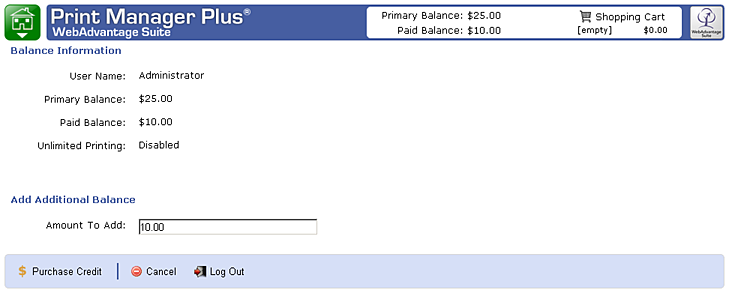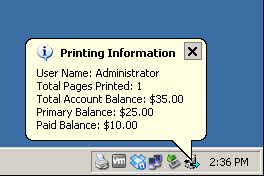What is Paid Balance?
Paid balance, also sometimes referred to as Secondary Balance is an additional balance that each user can carry. It is used to distinguish the balance for which they actually paid extra or separately for above and beyond the normal balance.
Example of Paid Balance Setting:
In this example, user John Doe has a balance of $25.00, but an additional $10 in paid balance for a total of $35.00 of printing allowed.

Main Advantages of Using Paid Balance
When a user purchases printing credit that is beyond the normal credits received, this credit should always be added to Paid Balance.
Separate Accounting of Purchased Credit:
When a user has paid for credits, keeping those credits separate rather than lumping it into the main balance allows or it to be accounted for separately. Below are the most common reasons:
Maintaining Paid Balance through Group & OU Quota Updates:
The next common advantage, is such that a paid balance is kept separate and intact through update schedules.
Scenario:
How Paid Balance is Deducted
Paid Balance starts deducting once the primary balance has reached 0.00. This is designed such that any account balance automatically provided to all users, that group, or that user’s organizational unit gets used first.
Case Example Job # 1 – 10.00 Print Job:
In this case, the user’s primary balance will be deducted, and the job does not cost enough to take any of his paid balance.

Case Example Job # 2 – 16.00 Print Job:
With this job, the user’s primary Balance alone cannot cover the entire job; some of the Paid balance is used to cover the cost.

Case Example Job # 3 – 8.00 Print Job:
With this job, the user’s primary balance is already 0, so the Paid balance will be checked to see if it is sufficient to cover the job. In this case it is.

Case Example Job # 4 – 5.00 Print Job:
This job will not be allowed to print at all as there is not enough combined balance to allow the job. No balance deduction or printing will take place.

Add-Ons that Support Paid Balance:
This web based add-on, allows users access to a portal where they can View their current Primary & Paid Balance and purchase additional credits to add to Paid Balance using a Credit Card or PayPal.

Reports Center:
This allows users to report on their current primary and paid balance, as well as report on their own printing and credit history.
End User Inquiry Tool:
This free utility runs on the Windows task tray and allows users to see their current balance.